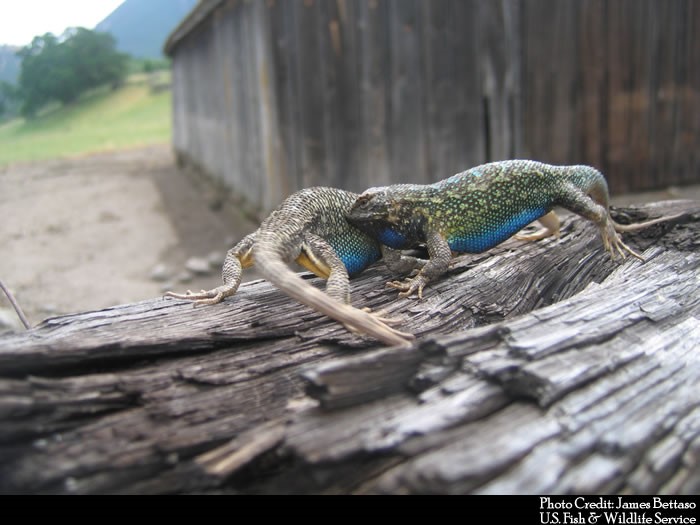Reproduction
Sceloporus occidentalis, like most lizards, mate and
then the female lays a clutch or group of eggs in a pit during
the spring and summer or mating season. The mating season ranges
from March to June, but more specifically the courtship and
copulation take place during these months (Nafis, 2013).
Goldberg’s study discovered that spermiogenesis starts in
February for lowland lizards and ovulated eggs were seen in
early April; however, the mountain lizards trail these dates by
six weeks (Goldberg, 1974). This possibly could be because of temperature
differences between the two ranges, and this shortening the
breeding cycle at high elevations. These two processes are
required for both male and female lizards before either one is
ready to produce offspring.
 During mating, a male defends his roughly defined territory of
up to twenty five feet radius (Nafis, 2013). He defends it by
posturing and by physical combat with other males (Morey, 1988).
The Western Fence Lizard male requires a perch site to observe
mates, rival males or to display (Morey, 1988). He will
ventrally flatten his body to display the bright colors and will
also perform “pushups,” or rapid up and down movements in order
to attract mates or display territorial defense (Fitch, 1938).
This allows the male to show off to the females from his high
perch, and to inform other males what is his. The defense of the
territory becomes less and less vigorous as the summer goes on.
Female Sceloporus occidentalis however, will not allow
the males to mate with her until she is ready, meaning that the
eggs are ovulated and she thinks the timing is right (Fitch,
1938). During copulation the male becomes brilliantly blue, blue
patches appear on all of his dorsal scales (Fitch, 1938). After
this the male’s job is finished and the rest is up to the
female.
During mating, a male defends his roughly defined territory of
up to twenty five feet radius (Nafis, 2013). He defends it by
posturing and by physical combat with other males (Morey, 1988).
The Western Fence Lizard male requires a perch site to observe
mates, rival males or to display (Morey, 1988). He will
ventrally flatten his body to display the bright colors and will
also perform “pushups,” or rapid up and down movements in order
to attract mates or display territorial defense (Fitch, 1938).
This allows the male to show off to the females from his high
perch, and to inform other males what is his. The defense of the
territory becomes less and less vigorous as the summer goes on.
Female Sceloporus occidentalis however, will not allow
the males to mate with her until she is ready, meaning that the
eggs are ovulated and she thinks the timing is right (Fitch,
1938). During copulation the male becomes brilliantly blue, blue
patches appear on all of his dorsal scales (Fitch, 1938). After
this the male’s job is finished and the rest is up to the
female.
Goldberg has done extensive studying on the reproduction of
populations of lowland and mountain lizards, and has discovered
that the Western Fence Lizard female is able to lay one to three
clutches in the low lands and one to two in the mountains
(Goldberg, 1974). The female lizards will mate several times over the
mating season and will produce several clutches of eggs. After
the female and male have mated, normally the female will lay the eggs two to four weeks after
copulation (Nafis, 2013). The clutch sizes range from three to
seventeen eggs, and there are slightly larger clutches laid in
the mountains. The females lay their eggs in pits that they have
dug in damp soil that is well aerated (Morey, 1988). They will
lay clutches from May to July, because of the several mating
between the males and females (Nafis, 2013). The eggs need
approximately ten weeks for development of young before they
start to appear in early July in the lowlands and in mid-August
in the mountains. The hatchlings measure 24-26 millimeters from
the snout to vent once they emerge from the pit that they were
laid in. The new young Western Fence Lizard will be able to mate
next spring, this completing the full cycle of reproduction.